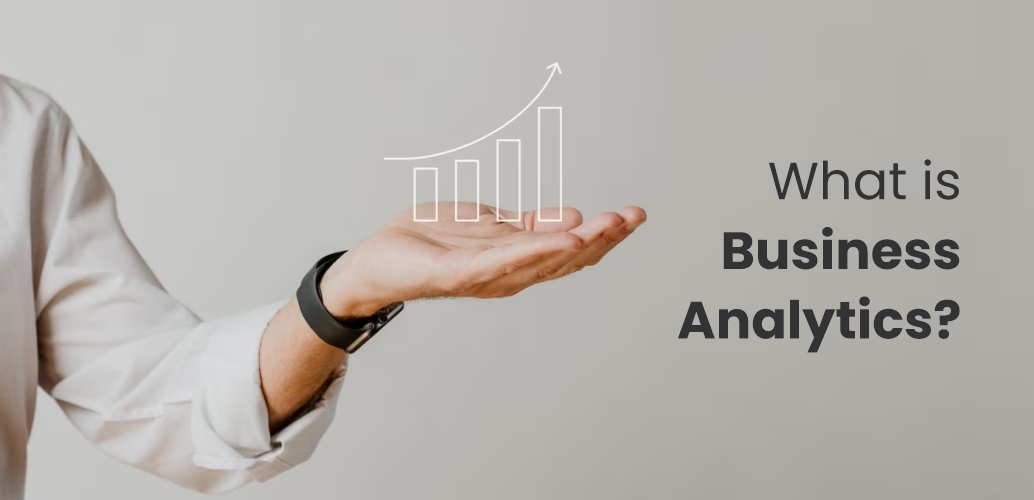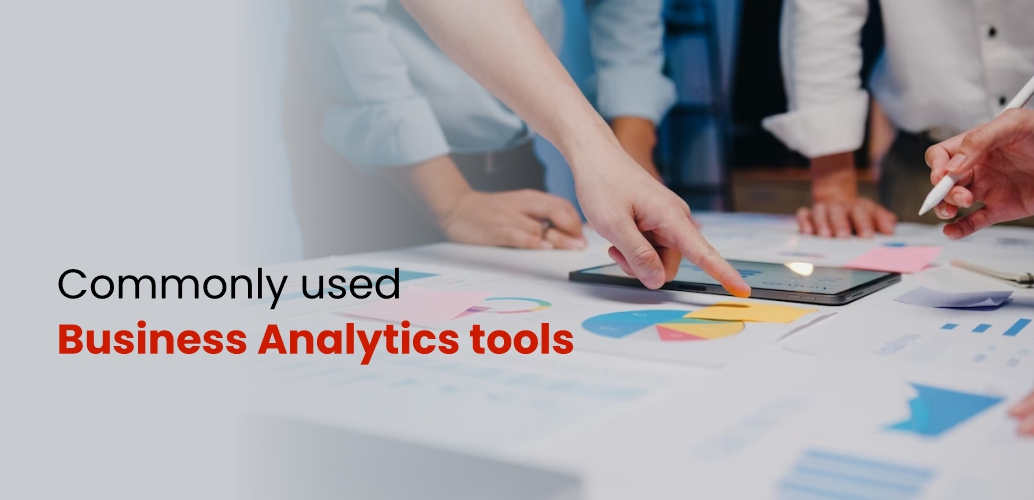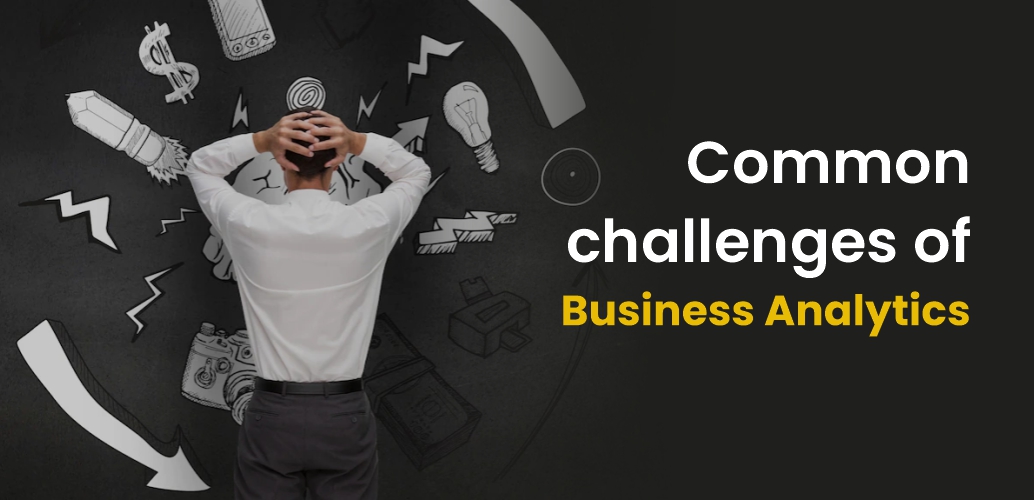Blog > What is Business Analytics? A Definitive Guide.
What is Business Analytics? A Definitive Guide.
January 31st, 2023

Table of Contents
-
- Benefits of Business Analytics
- Common tools used by Business Analysts
- How Business Analytics works
- Business analytics vs. business intelligence
- Business analytics vs. data analytics
- Business analytics vs. data science
- Common challenges of Business Analytics
- Why is data driven analytics of interest to companies
- Conclusion
Because of how valuable this field has become, companies are always on the lookout for professionals with business analyst training. Freshers can leverage this emerging sunrise sector by enrolling in business analyst courses to enhance their skills and secure a prosperous future. Business analyst certification can go a long way in helping students have a successful career and make them industry leaders in this domain.
This blog will serve as a definitive guide on business analytics. It will help demystify this fascinating domain and explain why it is so revolutionary for brands and industries alike. Let's embark on this delightful journey together.
What are the benefits of Business Analytics?
As we mentioned, Business Analytics is the process of gaining key insights using data, to make informed business decisions. Business Analysts help businesses refine historical data to find important facts. These insights can predict future trends and patterns that help the company make better decisions when it comes to investing in any venture. These insights help companies understand their customers better, and meet their demands. Further, Business Analytics helps companies boost profits and increase market share.Putting it simply, Business analysts look at the past to make better decisions for the future.
Business Analysts use 2 main types of analysis to achieve this - Descriptive Analysis and Predictive Analysis.
Descriptive Analysis involves studying historical data and past patterns to understand why a certain trend worked or why something didn’t work.
Predictive Analysis uses the collated refined data to make future predictions, or basically to make business forecasts and set up budgets for the near future.
For businesses, this is a very vital need. Large volumes of data and crucial insights in an understandable and readable form can make or break the business.
Commonly used Business Analytics Tools

- SAS Business Analytics (SAS BA) SAS stands for Statistical Analysis System. SAS is a software suite made for Data Management, Business Intelligence, Predictive Analysis and Descriptive Analysis.
- QlikView QlikView is a relational data analytics and BI solution for understanding and gaining insights from complex datasets. QlikView is used by companies like Mercedes Benz, Cognizant, TCS and more.
- Board Board, as the name suggests, is a management software. From scheduling meetings to sharing documents and minutes, the Board management software was made to streamline SOPs, ensure no oversights and make sure best practices are followed.
- Splunk Splunk is used for scanning and searching through Big data. It allows users to search, analyse and visualise the data gathered from many places like websites, applications, sensors, devices etc.
- Sisense Sisense is also a BI platform. Its users mainly use it to query databases, create data models and create dashboards from those data models, etc.
- Microstrategy MicroStrategy is a cloud-based business intelligence platform that helps with both data mining and visualisation.
- KNIME KNIME Analytics Platform is an open source software that, without any coding, allows users to access, blend, analyse, and visualise data.
- Tableau Tableau manages vast volumes of data and turns data into valuable insights. Since Tableau is used by almost every industry today, it has become one of the basic requirements recruiters look for in Business Analysts.
- Excel
Excel might be one of the oldest tools in the industry, however, it is still the popular analytical tool across all industries. Excel is a powerhouse of features that allows you to:
- Collect data
- Perform statistical analysis
- Make complex reports
- Integrate with other Business Intelligence tools like Power BI
- Power BI Power BI is mostly used for data visualisation. It contains standard data visuals that you can utilise to build interactive reports, such as bar, column, line, map, matrix, pie charts, scatter, table and waterfall.
How Business Analytics works
The goal of business analytics is to make sense of data and use it to make better business decisions. It is the process of gathering information from multiple sources, such as sales numbers, customer interactions, and market trends. Analysts can then find patterns, make forecasts, and discover new opportunities by employing tools such as statistical models and data visualisation.A retail organisation, for example, might employ business analytics to examine sales data and customer behaviour. They might learn which products are doing well, which aren't, and why. This data can then be used to make educated choices about inventory management, marketing strategies, and shop layout.
In brief, Business Analytics assists organisations in transforming data into actionable insights, allowing them to make better decisions and stay ahead of the competition.
Business analytics vs. Business Intelligence
BI refers to the tools and procedures that businesses use to collect and manage data, and then present it in a meaningful and understandable manner. The purpose of BI is to offer executives and decision-makers with a full and accurate picture of the business so that they can make educated decisions.BA, on the other hand, digs further into the material collected by BI. It is about evaluating the data and generating insights that might help businesses make better decisions. It's all about transforming raw data into valuable information that can be utilised to enhance business outcomes.
In simpler terms, there isn’t much of a difference between Business Intelligence and Business Analytics, except that BI provides you with the ‘what’ and ‘when’ of your business, whereas BA offers you the ‘why’ and ‘how’.
Read More : Which is better? Business intelligence or Data Analytics?
Business analytics vs. Data Analytics
Data Analytics and Business Analytics are both concerned with the analysis of data. There is, however, a difference between Data Analytics and Business Analytics.Data Analytics is a larger term for the process of analysing raw data to get insights and conclusions. It may be applied to any type of data and utilised for a wide range of applications, including scientific research, market research, and even personal data analysis.
Business Analytics, on the other hand, is a subset of data analytics that focuses on the analysis of one organisation's data. Business analytics' purpose is to use data to improve business performance and make sound business decisions. Data for Business Analytics looks something like this, sales figures, consumer data and company data. Business analytics uses data specific to one organisation. For example, one company’s consumer data, and financial data, as collected and refined, in order to assist management in making better decisions.
In summary, Data Analytics is a broader phrase, whereas Business Analytics is a specialised application of data analytics aimed at enhancing business performance.
Business Analytics vs. Data Science
Data Science is a vast field of study that involves gaining insights and usable information from data by using various tools and techniques. Some of these are statistical analysis, machine learning, and building predictive models. The goal of Data Science is to find or predict patterns, relationships and trends in data to drive innovation.Business Analytics, as we discussed, is a more specific application of analysis. It focuses on the data of one business. Business Analytics is often attentive towards key performance indicators (KPIs) and metrics that are important to a specific business, such as sales, marketing, and customer behaviour.
Common Challenges of Business Analytics

- Lack of Skilled Resources: It might be challenging to find people with the necessary abilities, skills and understanding to manage big data analytics.
- Gaining Big Data Insights: Working with big volumes of data may be intimidating, and extracting useful insights without experience or appropriate tools can be difficult.
- Bringing Data to Big Data Platforms: Integrating different data sources and translating them into an analytical format may be a time-consuming procedure.
- Data Management Landscape Uncertainty: Because the field of big data analytics is continually expanding, it can be difficult for Business Analysts to remain up to date on the newest technology and best practices.
- Data Storage and Fast Retrieval: Storing and rapidly accessing vast volumes of data can cause a hindrance in a Business Analyst’s job, if the data infrastructure is not up to date.
Roles and Responsibilities of a Business Analysts
By now we’ve understood the importance of Business Analysts, but let’s dive deeper into what their day-to-day responsibilities include:- Finding problems in the organisation, identifying opportunities, providing use cases for solutions and documenting them in a detailed business analysis
- Budgeting and forecasting using historical data to make predictions about future trends.
- Monitoring progress on various business initiatives that have been taken by the company
- Variance Analysis, which is basically finding the difference between the forecasted budgets and actual numbers. This helps to improve accuracy in the future.
- Defining business needs to the various stakeholders involved
- And understanding Key performance indicators for any business and keeping track of how they perform.
Why is data driven analytics of interest to companies
Data-driven insights are required for businesses to make educated decisions, increase operational efficiency, and gain a competitive advantage. With organisations producing a rising quantity of data, it is becoming increasingly critical to harness this data to produce better outcomes.Data-driven insights may assist businesses in the following ways:
- Improve decision-making: By analysing data, businesses may uncover trends, patterns, and linkages that can help them make better decisions.
- Improve operational efficiency: By examining operational data, businesses may discover areas for improvement and optimise procedures to boost efficiency.
- Gain a competitive advantage: Companies that embrace data-driven insights can outperform those that rely on intuition or guesswork.
Conclusion

Also Read : Industry Insights: Business Analytics Salary and Job Outlook






Add a Comment